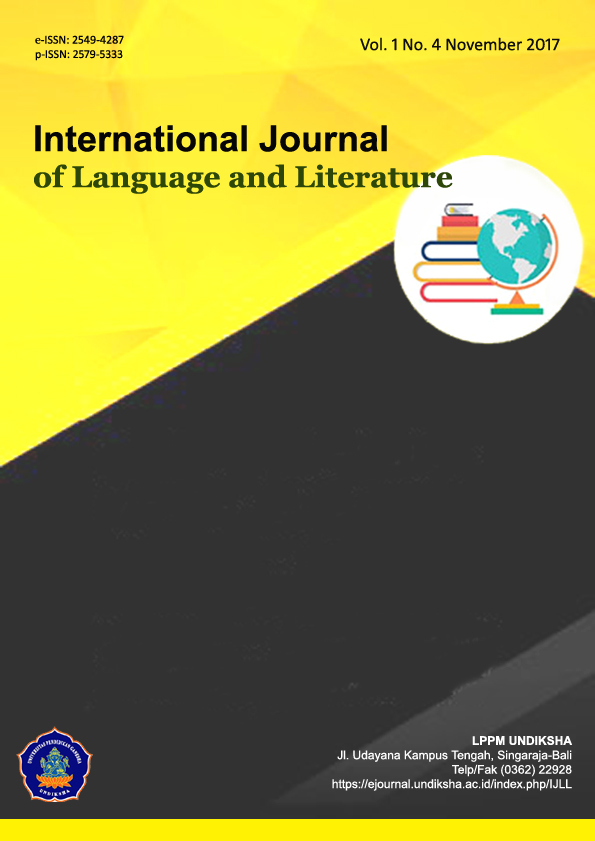COPING WITH BIG CLASSES: EFFECT OF BIG BOOK IN FOURTH GRADE STUDENTS READING COMPREHENSION
DOI:
https://doi.org/10.23887/ijll.v1i4.12583Keywords:
big book, reading comprehension, young learner.Abstract
Teaching reading comprehension for young learners becomes a challenge for English teachers in Indonesia. Dealing with that problem, this study had a purpose to investigate whether there was any significant effect on students’ reading comprehension taught by using big book and conventional media or not. Post-test only control group was used as the design with forth grade students of SD Laboratorium Undiksha Singaraja as the population. The data were analyzed descriptively and inferentially. As the result, it can be concluded that big book gives significant effect on students reading comprehension compared with the control group. It can be proven from the difference of mean score gained by experimental group (83.56) and control group (76.19). The result of the t-test also shows that the t-observed exceeded the t-critical value (4.088 > 2.042).
References
Alshumaimeri, Y. (2011). The effects of reading method on the comprehension performance of Saudi EFL students, 4(1), 185–195.
Brown, E. The bases of reading acquisition. Reading Research Quarterly, 1970, 6, 49-74
Connor, O. (2006). Using Big Books : A Standards-Based Instructional Approach for Foreign Language Teacher Candidates in a PreK – 12 Program, 39(3), 487–506.
Djalal, S. A. (2017). The Advantages Of Teaching English To Young Learners By Using Obot Game Song. The 2nd Teylin International Conference, (April), 201–206.
Fahmi, D. I., Suhartono, L., & Arifin, Z. (2014). Improving students’ reading comprehension using big book, 1–11.
Fitriani, Ika, Cahyono, B. Y. (1997). The Effectiveness Of Implementing Big-Book And Narrative-Scaffold On The Students’ Achievement In Writing Narrative Texts, 1–13.
Harun, Rahim, N. A. (2010). Students ’ Perception Towards The Usage of the Big Book. Gadiing Business and Management, 14(2003), 48–54.
Lasmiatun,Sri (2016). The Implementation of Story Grammar Strategy in Teaching Narrative Test for VIII Grade Students at MTs Al Ma'Arif Tuluangagung.
Mahayanti, N. W. S., & Suantari, N. L. P. M. (2017). Developing Big Book as a Media for Teaching English at Sixth Grade Students of Elementary School at SD Lab Undiksha Singaraja. . Journal of Education Research and Evaluation. Vol., 1(2017), 128–136.
Michele, H. (2013). Reading Comprehension : Strategies for Elementary and Secondary School Students Michele Harvey 225 Farmdale Drive Madison Heights , VA 24572 Lynchburg College, 2–17.
Nambiar, M. (1991). Big books for little read- ers: Works in the ESL classroom too. (Eric Document Reproduction Service No. ED 333 736).
Paul, David. (2003). Teaching Englishto Children in Asia. Hong Kong: Pearson Education Asia Ltd.
Rahmawati, L., Padmawati, N., & Ratminingsih, M. (2014). The Effect Of Circ Strategy And Achievement Motivation Toward Students ’ Reading Comprehension. E-Journal Program Pascasarjana Universitas Pendidikan Ganesha, 3(1980), 1–12.
Salmi, M. Al. (2011). S Chemata ( Background Knowledge ) And By By. Research Journal Specific Education, (22), 696–708.
Snow, C. (2002). Reading for Understanding Toward an R & D Program in Reading Comprehension. Office of Educational Research and Improvement. Retrieved from http://www.rand.org/publications/MR/MR1465/
Somadayo, S., Nurkamto, J., & Suwandi, S. (2013). The Effect of Learning Model Drta ( Directed Reading Thingking Activity ) Toward Students ’ Reading Comprehension Ability Seeing from Their Reading Interest, 4(8), 115–123.
Sukarno. (2008). Teaching English To Young Learners And Factors To Consider In Designing The Materials Oleh: Sukarno (Faculty of Languages and Arts Yogyakarta State University), 57–73.
Suyanto, K.K. E. 2007. English for Young Learners. Jakarta: Bumi Aksara.
Tatminingsih, S. (2013). International Conference On Educational Research and Innovation. In Big Book, A Teaching Alternative For Improving Children’s Reading Readiness In Kindergarten. Yogyakarta: UNY Press.
Tatminingsih, S. R. I. (2013). Big Book , A Teaching Alternative For Improving Children ’ S Reading Readiness In, 1–12.
Yuliana. (2003). Teaching English to Young Learners through Songs, 5(1), 62–66.
Yuliarsianita,K.A.M. (2016). Developing Character Based Big Book As Media For,1-131
Downloads
Published
How to Cite
Issue
Section
License
IJLL Journal provides immediate open access to its content on the principle that making research freely available to the public to supports a greater global exchange of knowledge.

This work is licensed under a Creative Commons Attribution-ShareAlike 4.0 International License








